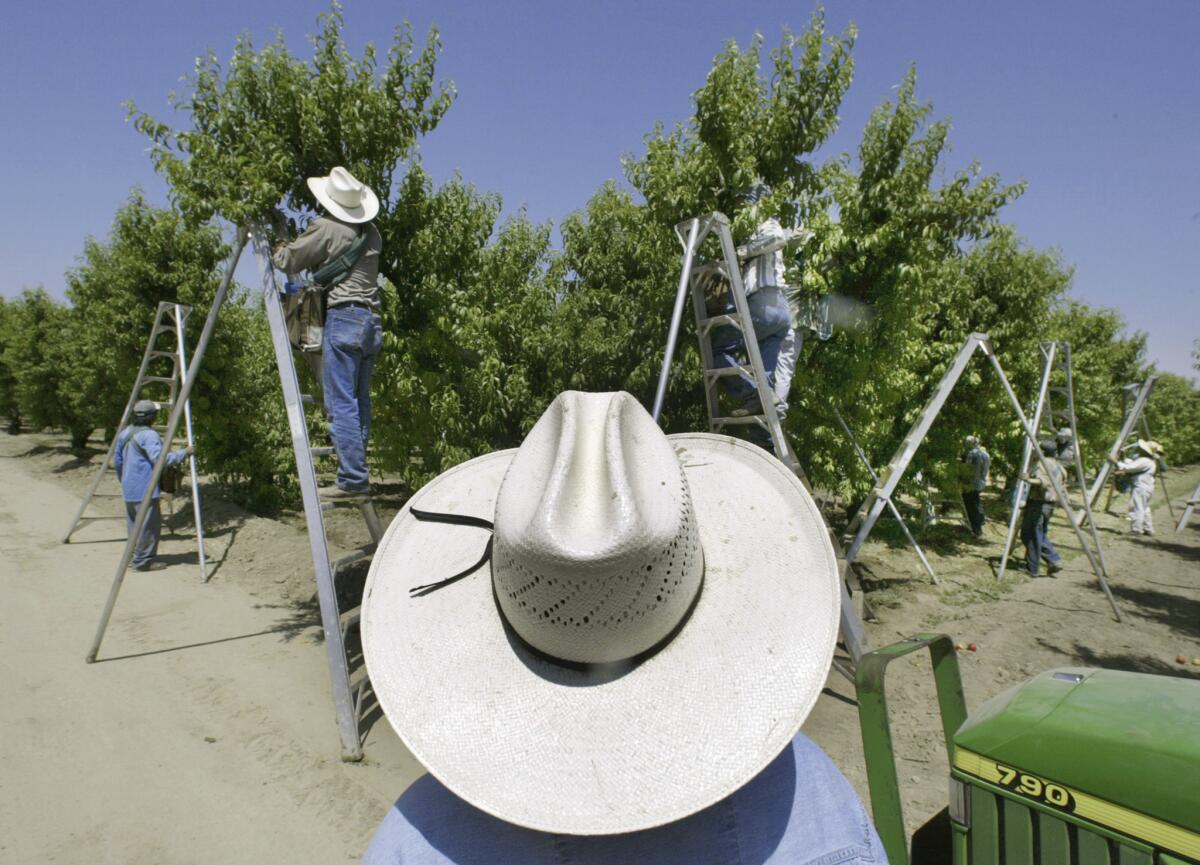Trump defended a pesticide linked to developmental disorders. California will ban it

- Share via
California regulators on Wednesday took formal legal steps to ban a widely used pesticide that had been rescued from elimination by the Trump administration.
The move by the state Environmental Protection Agency is all but certain to draw legal challenges from Corteva Agriscience (formerly Dow AgroSciences), which has pushed back at attempts by environmentalists to ban the chemical, chlorpyrifos, on a federal level.
The state is the largest user of chlorpyrifos — more than 900,000 pounds of it was applied in 2017 to almonds, grapes, citrus, alfalfa, stone fruit, cotton and other crops, according to state data.
Exposure to the organophosphate nerve agent has been linked to developmental disorders and neurological damage in animals and humans.
The ban is the first time the state has unilaterally barred an actively used pesticide, and will take effect in 15 days unless opposing parties request an administrative hearing.
The federal EPA is unlikely to challenge California, which often goes its own way on environmental matters, including auto emissions and climate regulation. An official from the federal agency said states are free to enact their own pesticide regulations so long as they are at least as strict as federal rules.
State EPA chief Jared Blumenfeld said California opted for an outright ban because it could find no way to tighten rules enough to ensure public safety without making applications of the chemical ineffective. In May, the agency announced it would revoke all chlorpyrifos product registrations, leading to Wednesday’s formal cancellation notices sent to 13 manufacturers and pest-management companies.
Blumenfeld called on his federal counterpart to refocus attention on the chemical’s hazards.
“They have that same science; they have that same legal basis, and yet, based on what appears from the outside to just be politics, they’ve been foot-dragging — and in fact worse than that, not taking their regulatory role seriously,” Blumenfeld said. “We have to step into the void and take action where the federal government has failed to do so.”
The state has been gradually tightening its restrictions on use of the chemical, so “farmers knew this was coming,” Blumenfeld said. “The handwriting has been on the wall for some time.”
Although growers have cut their use of the chemical by about half over the past decade, they have been uneasy about the state’s earlier signals that a ban was coming.
The citrus industry uses chlorpyrifos to combat the Asian citrus psyllid, which can spread a disease that can decimate entire groves. The pesticide also is critical to controlling leaffooted bugs and stink bugs in almond groves.
“California farmers are resilient, but the long-term viability of our farms in California depends on proper support from the administration and renewed cooperation of the state’s regulatory agencies, especially in light of the many other unique and expensive regulations that place California farmers at a growing competitive disadvantage,” Tom Nassif, president and chief executive of Western Growers, a regional industry group, said in May.
Val Dolcini, acting director of the state EPA’s Department of Pesticide Regulation, said he was “quite confident” that a newly formed working group, including academic, agricultural, regulatory and environmental experts, would identify an array of alternatives to the chemical. The state has allocated about $5 million in grants toward that end, he said.
Chlorpyrifos has become something of a poster child for the Trump administration’s rollback of regulation, which has occurred at times in defiance of scientific findings about health and environmental harm.
Former EPA administrator Scott Pruitt halted an Obama-era ban that had been hastened by a court order, and his successor, Andrew Wheeler, has since extended the safety review of the pesticide through 2022. California, six other states and a host of environmental and labor groups have sued over those moves.
A federal EPA spokesman said on Wednesday that the agency has responded to complaints about its decisions by expediting the review process — it now expects to make an interim decision by October 2020, followed by a public review process.
More to Read
Inside the business of entertainment
The Wide Shot brings you news, analysis and insights on everything from streaming wars to production — and what it all means for the future.
You may occasionally receive promotional content from the Los Angeles Times.











